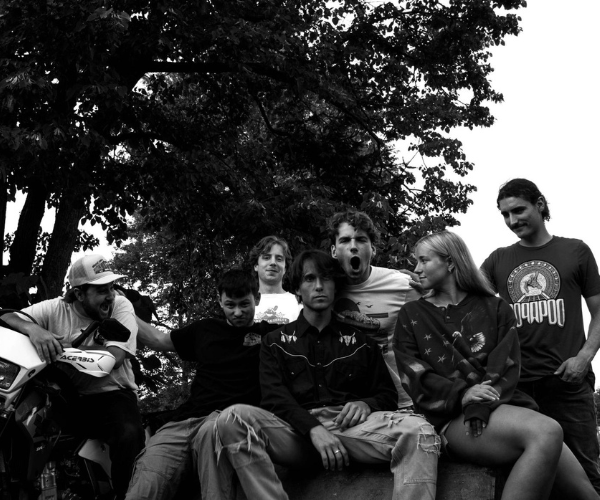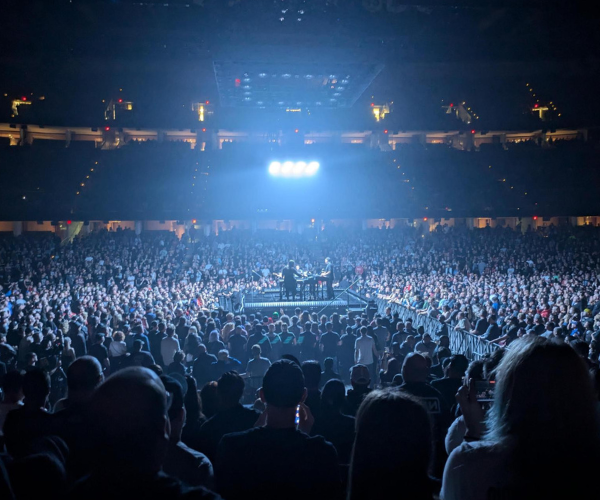A guard undoes the padlock on a tall plywood door, and chief curator Griff Mann leads the way into the Cleveland Museum of Art’s unfinished contemporary art galleries.
The huge room’s ceilings reach far above us. Our footsteps tap across cardboard. Blueprints lie curled atop a wooden worktable. An Andy Warhol painting of 100 Marilyn Monroes is propped up against one wall.
We stop at a giant tube of toothpaste lying atop a crate — artwork by Claes Oldenburg, the sculptor/prankster who created Cleveland’sFree Stamp. Nearby, the Jackson Pollock splatter-paintingNumber 5 and Mark Rothko’sRed Maroons, with its brooding burgundy rectangles, also lean against the new walls, little carpeted cushions between them and the covered floor.
It’s mid-April, two months before the June 27 public debut of the art museum’s East Wing, the first new building completed as part of a $350 million renovation. Designed by world-renowned architect Rafael Viñoly, the East Wing is now the elegant, edgy home of the museum’s modern, contemporary and 19th-century European and American art.
“There’s going to be a lot more to see of the collection,” says Mann, who became chief curator last year — “a core part of the collection that people value.”
The East Wing’s opening is a major step in the museum’s rebirth. For the first time since the museum closed its galleries for renovation in 2005, visitors will be able to enjoy most of the history of European and American art, from medieval times and the colonial period to today.
The spacious East Wing galleries will hold 470 artworks, many more than the former location. Photography gets three rooms, compared to one narrow hallway before. Works acquired since 2005 will also debut in June, including video installations.
Plus, an entire room is dedicated to the work of Cleveland artists — including a newly acquired 1957 painting by Cleveland School of Art graduate Hughie Lee-Smith,Untitled (Rooftop View), which shows a young black man standing atop a building, gazing away in thought.
This spring, museumgoers stole glimpses through the glass gallery walls of some of the museum’s most beloved modernist paintings. Many of these works toured the world in the Modern Masters exhibit, which took place during the renovation.
Now Claude Monet’s immense and beautiful Water Lilies, a signature piece from the artist’s late years, faces a set of sliding glass doors, greeting visitors.
Viñoly’s design, with its high ceilings, open rooms and natural lighting, creates dramatic sight lines and broad walls that sparked the curators’ creativity.
In one gallery, two large and radically different mother-and-child portraits from 1879 hang side by side. Albert Besnard’sMadeleine Lerolle and Her Daughter Yvonne represents a modernist painting’s brilliant rebellion, whileRest, William Adolphe Bouguereau’s lifelike portraiture of Italian peasants, represents an art establishment that the upstarts overturned.
Nearby, I stop at one of my favorite paintings in the museum, Odilon Redon’s Vase of Flowers, a symbolist dream-vision of explosively vivid blossoms. Mann says he hopes longtime museum visitors will experience “a revelation” when they see their favorite pieces in the East Wing. “It’s like seeing old friends in new contexts,” he says.
One of Viñoly’s daring touches, a gallery with three glass walls overlooking East Boulevard, challenged curators: They had to fill it with art that could withstand sunlight. So they compiled an entire room of sculpture by Auguste Rodin, the master of modern sculpture.
The museum owns many of Rodin’s works (including a bust ofThe Thinker, which stands on the steps leading to Wade Lagoon). Previously, they were scattered about. Now nine Rodin pieces, in media from plaster and bronze and from different periods, are grouped together.
“I can’t wait to see people in these spaces,” says Mann. “It’s usually in that first minute or so when you know whether or not there’s been a difference made in the work you’ve done — that sense of an intake of breath as they walk into a room.”
The huge room’s ceilings reach far above us. Our footsteps tap across cardboard. Blueprints lie curled atop a wooden worktable. An Andy Warhol painting of 100 Marilyn Monroes is propped up against one wall.
We stop at a giant tube of toothpaste lying atop a crate — artwork by Claes Oldenburg, the sculptor/prankster who created Cleveland’sFree Stamp. Nearby, the Jackson Pollock splatter-paintingNumber 5 and Mark Rothko’sRed Maroons, with its brooding burgundy rectangles, also lean against the new walls, little carpeted cushions between them and the covered floor.
It’s mid-April, two months before the June 27 public debut of the art museum’s East Wing, the first new building completed as part of a $350 million renovation. Designed by world-renowned architect Rafael Viñoly, the East Wing is now the elegant, edgy home of the museum’s modern, contemporary and 19th-century European and American art.
“There’s going to be a lot more to see of the collection,” says Mann, who became chief curator last year — “a core part of the collection that people value.”
The East Wing’s opening is a major step in the museum’s rebirth. For the first time since the museum closed its galleries for renovation in 2005, visitors will be able to enjoy most of the history of European and American art, from medieval times and the colonial period to today.
The spacious East Wing galleries will hold 470 artworks, many more than the former location. Photography gets three rooms, compared to one narrow hallway before. Works acquired since 2005 will also debut in June, including video installations.
Plus, an entire room is dedicated to the work of Cleveland artists — including a newly acquired 1957 painting by Cleveland School of Art graduate Hughie Lee-Smith,Untitled (Rooftop View), which shows a young black man standing atop a building, gazing away in thought.
This spring, museumgoers stole glimpses through the glass gallery walls of some of the museum’s most beloved modernist paintings. Many of these works toured the world in the Modern Masters exhibit, which took place during the renovation.
Now Claude Monet’s immense and beautiful Water Lilies, a signature piece from the artist’s late years, faces a set of sliding glass doors, greeting visitors.
Viñoly’s design, with its high ceilings, open rooms and natural lighting, creates dramatic sight lines and broad walls that sparked the curators’ creativity.
In one gallery, two large and radically different mother-and-child portraits from 1879 hang side by side. Albert Besnard’sMadeleine Lerolle and Her Daughter Yvonne represents a modernist painting’s brilliant rebellion, whileRest, William Adolphe Bouguereau’s lifelike portraiture of Italian peasants, represents an art establishment that the upstarts overturned.
Nearby, I stop at one of my favorite paintings in the museum, Odilon Redon’s Vase of Flowers, a symbolist dream-vision of explosively vivid blossoms. Mann says he hopes longtime museum visitors will experience “a revelation” when they see their favorite pieces in the East Wing. “It’s like seeing old friends in new contexts,” he says.
One of Viñoly’s daring touches, a gallery with three glass walls overlooking East Boulevard, challenged curators: They had to fill it with art that could withstand sunlight. So they compiled an entire room of sculpture by Auguste Rodin, the master of modern sculpture.
The museum owns many of Rodin’s works (including a bust ofThe Thinker, which stands on the steps leading to Wade Lagoon). Previously, they were scattered about. Now nine Rodin pieces, in media from plaster and bronze and from different periods, are grouped together.
“I can’t wait to see people in these spaces,” says Mann. “It’s usually in that first minute or so when you know whether or not there’s been a difference made in the work you’ve done — that sense of an intake of breath as they walk into a room.”



